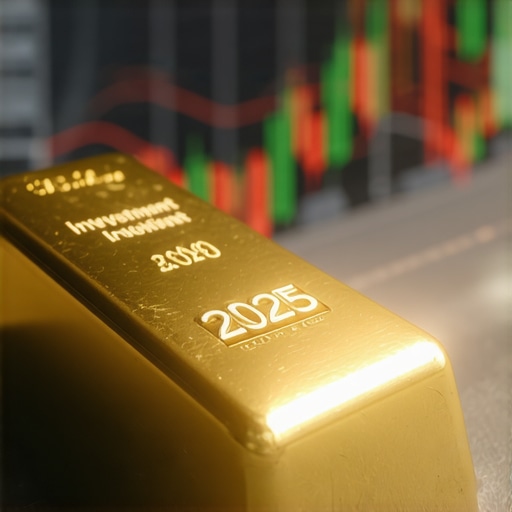Gold’s Unique Position in Inflation Hedging and Risk Management
In the complex landscape of modern financial markets, gold remains a distinctive asset, renowned for its resilience against inflationary pressures and market volatility. Unlike fiat currencies, whose purchasing power erodes due to inflation, gold possesses intrinsic value rooted in its scarcity and historical acceptance as a store of wealth. This article delves into the multifaceted mechanisms by which gold functions as a hedge, illuminating its role within diversified portfolios to mitigate economic uncertainties.
Macroeconomic Mechanisms Underpinning Gold’s Hedge Properties
Gold’s efficacy as an inflation hedge stems from its inverse correlation with the real interest rates and the diminishing confidence in fiat currencies during inflationary cycles. When inflation rises, central banks may increase nominal interest rates; however, if real rates remain negative, gold prices typically ascend as investors seek refuge from currency depreciation. This dynamic is intricately linked to gold’s function as a non-yielding asset, which paradoxically benefits during periods of monetary expansion and fiscal stimulus.
How Does Gold’s Role Differ from Other Inflation-Protected Assets?
Unlike Treasury Inflation-Protected Securities (TIPS) or inflation-indexed bonds, gold does not provide periodic cash flows, which means its value appreciation relies solely on market demand and supply dynamics. However, gold’s advantage lies in its global liquidity, lack of counterparty risk, and tangible physical presence, making it a reliable store of value when traditional financial instruments falter. This distinct profile offers a complementary hedge, especially during stagflation or geopolitical uncertainties where other assets may underperform.
Gold’s Role in Mitigating Market Risk and Portfolio Volatility
Beyond inflation hedging, gold serves as a strategic asset for risk mitigation. Historical data reveals that gold often exhibits low to negative correlation with equities and bonds during market downturns, providing a diversification benefit that can reduce overall portfolio volatility. Institutional investors frequently allocate a portion of their portfolios to gold or gold-related instruments to enhance risk-adjusted returns, particularly in anticipation of systemic shocks or currency crises.
Integrating Gold Into Advanced Investment Portfolios
Experts recommend a nuanced approach to gold investment, balancing physical bullion, gold ETFs, and mining stocks to optimize exposure. Physical gold offers tangible security, while ETFs provide liquidity and ease of trading. Mining stocks introduce operational risks but can amplify gains during bullish gold markets. For a comprehensive strategy, see the top gold investment strategies to protect wealth against inflation, which detail advanced portfolio structuring techniques.
Authoritative Perspectives and Market Dynamics
Academic research, such as the article published by the Journal of Financial Economics, substantiates gold’s role as a long-term inflation hedge and safe haven asset. Moreover, central bank gold buying patterns significantly influence global demand and price volatility, underscoring gold’s embeddedness in macroeconomic policy considerations. Investors should remain cognizant of these broader drivers when constructing exposure to gold, ensuring alignment with their risk tolerance and investment horizon.
Ready to elevate your investment strategy? Explore our expert-level guides on analyzing gold market trends for smarter investment moves and contribute your insights to the evolving dialogue on gold’s strategic role in portfolio management.
Exploring Gold’s Interaction with Currency Fluctuations and Global Economic Policies
Gold’s behavior is profoundly influenced by currency dynamics and the monetary policies of major economies. As a globally traded asset priced predominantly in US dollars, fluctuations in the USD affect gold’s attractiveness as an inflation hedge. When the dollar weakens, gold prices generally rise as it becomes cheaper for holders of other currencies, amplifying demand. Conversely, a strong dollar can suppress gold prices despite inflationary pressures. Additionally, central banks’ monetary policies, such as quantitative easing or interest rate adjustments, indirectly shape gold’s investment appeal by altering real interest rates and inflation expectations.
What Are the Implications of Emerging Market Demand for Gold on Long-Term Price Stability?
Emerging markets, particularly in Asia, have seen a surge in gold demand driven by cultural affinity, wealth accumulation, and investment diversification. This growing appetite adds a structural component to gold’s demand profile, potentially stabilizing prices over the long term despite cyclical volatility. Investors should consider how these demographic and economic shifts interplay with traditional Western market factors to inform their strategic allocation decisions. Understanding this demand evolution is critical for anticipating gold’s future role in global portfolios.
For a deeper dive into how gold supply and demand trends impact pricing, explore our detailed analysis on gold supply and demand insights for smarter investing.
Leveraging Gold’s Portfolio Benefits Through Sophisticated Allocation Models
Advanced portfolio management incorporates gold not only as a hedge but as an active component of optimization algorithms. Modern portfolio theory underlines gold’s low correlation with traditional assets, enhancing diversification and potentially improving the Sharpe ratio. Strategic allocation often involves dynamic weighting based on macroeconomic indicators, inflation forecasts, and geopolitical risk assessments. Utilizing gold derivatives alongside physical holdings and equities can fine-tune exposure and risk management, optimizing returns under varying market regimes.
A practical approach for investors is to integrate gold ETFs and mining stocks with physical bullion to capture diverse risk-return characteristics. For comprehensive guidelines on assembling such balanced portfolios, refer to our resource on how to build a portfolio with gold ETFs and mutual funds.
Credible Frameworks for Assessing Gold’s Inflation Hedge Effectiveness
Quantitative research methodologies, including regression analyses and cointegration tests, provide robust frameworks to assess gold’s responsiveness to inflation metrics. Studies have demonstrated that gold’s hedge effectiveness varies across inflation regimes and time horizons, necessitating nuanced interpretation rather than blanket assumptions. Incorporating factors like real interest rates, inflation expectations, and geopolitical risk indices enhances predictive accuracy. Such analytical rigor equips investors with the tools to time gold exposures strategically.
A seminal paper by Baur and Lucey (2010), published in the Journal of International Financial Markets, Institutions and Money, rigorously examines gold’s role as a hedge and safe haven, reinforcing its complex but critical function in diversified portfolios.
Join the Conversation: How Are You Adjusting Your Gold Strategy Amidst Evolving Global Risks?
Your insights and experiences enrich the collective understanding of gold’s strategic value. Share your perspectives in the comments below or explore more expert guides such as effective gold investment strategies for economic uncertainty to stay ahead in your investment journey.
Decoding the Intricacies of Gold and Currency Volatility: A Macro-Financial Nexus
Gold’s sensitivity to currency fluctuations, particularly the US dollar, reveals a nuanced interplay that sophisticated investors must master. The inverse relationship between gold prices and the dollar’s strength is not merely a function of exchange rates but also reflects deeper macroeconomic signals such as monetary policy divergence between major economies. For instance, when the Federal Reserve adopts a dovish stance while other central banks tighten, the dollar often weakens, enhancing gold’s appeal internationally. This dynamic is further complicated by cross-currency basis spreads and capital flows, which can temporarily decouple gold prices from traditional currency correlations.
Moreover, understanding the implications of currency hedging costs and their impact on gold-denominated assets can significantly alter portfolio outcomes. Investors operating in non-USD jurisdictions must weigh the cost-benefit of hedging gold exposure versus embracing currency risk as a diversification tool, especially in emerging markets with volatile exchange rates.
Can Currency Hedging Enhance Gold’s Inflation Hedge Role in Multinational Portfolios?
This advanced question probes the strategic impact of currency risk management on gold’s inflation-hedging efficacy. Empirical studies, such as those published by the CFA Institute, illustrate that while hedging can reduce volatility and improve risk-adjusted returns, it may also diminish the natural inflation offset that gold provides. Consequently, a selective approach—hedging certain currency exposures while maintaining others unhedged—can optimize the inflation hedge benefit depending on the investor’s base currency and inflation outlook.
Optimizing Portfolio Integration: Employing Quantitative Techniques for Gold Allocation
Advanced investors increasingly leverage quantitative methods to determine optimal gold allocations. Techniques such as mean-variance optimization, conditional value-at-risk (CVaR) frameworks, and machine learning-driven predictive models provide enhanced precision in balancing risk and return. These methodologies account for dynamic correlations, tail risks, and regime shifts, allowing portfolios to adapt to evolving economic conditions.
For example, regime-switching models can dynamically adjust gold weights based on inflationary signals or geopolitical stress indicators, enabling proactive rather than reactive portfolio adjustments. Additionally, employing factor analysis to decompose gold returns into drivers such as real rates, currency movements, and market sentiment uncovers latent patterns that traditional allocation methods might overlook.
How Can Machine Learning Algorithms Improve Gold Allocation Decisions Under Market Uncertainty?
Machine learning offers promising avenues for enhancing gold investment strategies by identifying non-linear relationships and subtle market signals imperceptible to classical models. Techniques like random forests, gradient boosting, and neural networks can integrate vast datasets—from macroeconomic indicators to sentiment analysis—facilitating adaptive allocation strategies that respond swiftly to market regime changes.
However, it is critical to approach these models with rigorous validation and interpretability considerations, ensuring that model outputs align with economic rationale and do not overfit historical anomalies. As noted by research published in the Journal of Economic Dynamics and Control, hybrid approaches combining domain expertise with machine learning yield the most robust results.
Investors seeking to implement these sophisticated strategies should continuously refine their models and integrate expert judgment to navigate the complexities of gold’s multifaceted role in portfolios.
Unveiling Sophisticated Risk-Adjusted Strategies in Gold Allocation
Contemporary portfolio management transcends traditional heuristics by embracing quantitative rigor and innovative computational techniques to optimize gold allocation. Beyond merely serving as a static hedge, gold’s dynamic integration into portfolios requires models that capture temporal dependencies, regime shifts, and multifactor interactions. These advanced frameworks empower investors to fine-tune exposure, balancing inflation protection with volatility control amid complex market environments.
How Do Machine Learning Models Enhance Gold Allocation Amidst Economic Regime Shifts?
Machine learning algorithms excel at detecting nonlinear patterns and adapting to evolving economic conditions, which classical models often overlook. For instance, ensemble methods like gradient boosting or deep learning architectures can synthesize heterogeneous data sources—ranging from real-time macroeconomic indicators to sentiment analytics—to forecast gold’s performance under varying inflationary regimes and geopolitical tensions. These data-driven insights facilitate proactive rebalancing strategies, improving portfolio resilience.
However, practitioners must institute robust validation protocols to mitigate overfitting and ensure interpretability, often integrating domain knowledge to contextualize model outputs. As documented in the Journal of Economic Dynamics and Control, hybrid approaches that couple econometric theory with machine learning deliver superior predictive accuracy and practical applicability.
Macro-Financial Nexus: Currency Volatility and Gold’s Strategic Positioning
In-depth understanding of currency dynamics is imperative for global investors incorporating gold. The intricate interdependencies between the US dollar’s monetary policy stance and cross-border capital flows create transient decoupling effects that can distort gold’s traditional inverse relationship with the dollar. Moreover, currency hedging decisions critically influence realized returns and inflation-hedging efficacy, particularly in emerging market portfolios where exchange rate volatility can be pronounced.
Can Selective Currency Hedging Optimize Gold’s Role in Multinational Portfolios?
Empirical evidence from the CFA Institute highlights a nuanced trade-off: while currency hedging attenuates volatility, it may inadvertently reduce gold’s natural inflation offset. Advanced strategies advocate for selective hedging, informed by base currency exposure, inflation forecasts, and geopolitical risk assessments, thereby tailoring risk-return profiles to investor-specific contexts.
Charting Emerging Market Demand: Structural Implications for Gold’s Long-Term Stability
The burgeoning gold demand in emerging economies, fueled by rising affluence and cultural predilections, introduces a structural dimension that may temper cyclical price volatility. This demographic-driven demand acts as a stabilizing anchor, supplementing traditional macroeconomic drivers and enhancing gold’s strategic portfolio role. Investors integrating these global demand shifts can anticipate more robust long-term price support, thereby refining allocation strategies accordingly.
For a comprehensive exploration of supply-demand dynamics and their investment implications, consult our detailed exposition on gold supply and demand insights for smarter investing.
Engage with Leading-Edge Gold Investment Insights
Elevate your portfolio sophistication by harnessing these advanced analytical frameworks and nuanced market understandings. Participate in our expert forums or deep-dive into specialized resources such as effective gold investment strategies for economic uncertainty to refine your approach in an ever-evolving global financial landscape.
Expert Insights & Advanced Considerations
Dynamic Allocation Enhances Gold’s Inflation Hedge Efficacy
Incorporating adaptive weighting schemes based on inflation forecasts and macroeconomic indicators significantly improves gold’s role in portfolio inflation protection. Static allocations often miss regime shifts, whereas dynamic strategies, especially those employing regime-switching models, enable investors to adjust exposure proactively, optimizing risk-adjusted returns.
Selective Currency Hedging Balances Risk and Inflation Protection
For multinational portfolios, selectively hedging currency exposure can refine gold’s inflation hedge benefits. While full hedging reduces volatility, it might also diminish gold’s natural inflation offset. Tailored hedging strategies that consider base currency, inflation outlook, and geopolitical risk provide a nuanced balance between stability and inflation protection.
Integrating Physical Gold with ETFs and Mining Stocks for Robust Exposure
A diversified approach blending physical bullion, gold ETFs, and mining equities captures distinct risk-return profiles and liquidity characteristics. Physical gold offers tangible security; ETFs provide trading flexibility; mining stocks contribute potential leveraged returns. This combination enhances portfolio resilience against inflation and market volatility.
Machine Learning Unlocks Nonlinear Patterns in Gold Market Dynamics
Implementing machine learning algorithms such as gradient boosting or neural networks uncovers subtle signals amid macroeconomic and sentiment data, enabling more precise timing and allocation of gold investments. However, rigorous validation and interpretability remain essential to avoid overfitting and ensure economic rationale consistency.
Emerging Market Demand Adds Structural Support to Gold Prices
The growing gold appetite in emerging economies, driven by demographic and cultural factors, provides a stabilizing influence on gold prices. This structural demand complements traditional macroeconomic drivers, enhancing gold’s long-term inflation hedging reliability within global portfolios.
Curated Expert Resources
Journal of Financial Economics: This peer-reviewed journal offers rigorous academic research validating gold’s long-term role as an inflation hedge and safe haven, essential for deepening theoretical understanding.
CFA Institute Research Digest: Provides empirical analyses on currency hedging and international diversification strategies, directly informing nuanced gold allocation in multinational portfolios.
Journal of Economic Dynamics and Control: Explores hybrid econometric and machine learning approaches, delivering advanced methodologies for predictive modeling in gold investment strategies.
BuyingGoldNow.com – Top Gold Investment Strategies to Protect Wealth: A practical resource detailing advanced portfolio structuring techniques that integrate physical gold, ETFs, and mining stocks for optimal inflation protection (Read more).
BuyingGoldNow.com – Gold Supply and Demand Insights for Smarter Investing: Offers comprehensive analysis on global demand trends, including emerging market impacts, essential for anticipating gold’s price dynamics (Explore this analysis).
Final Expert Perspective
Gold’s multifaceted role as an inflation hedge and risk mitigation asset remains indispensable in sophisticated portfolio management. Embracing dynamic allocation models, selective currency hedging, and diversified exposure across physical bullion, ETFs, and mining stocks equips investors to navigate evolving economic landscapes effectively. Additionally, harnessing machine learning techniques and factoring in emerging market demand trends provides a competitive edge in optimizing gold allocation strategies. For those seeking to advance their understanding and implementation of gold investments, engaging with authoritative resources and adopting these nuanced approaches is paramount. Explore more expert insights and elevate your strategy with comprehensive guides such as top gold investment strategies to protect wealth against inflation to stay ahead in the complex terrain of gold investing.











This comprehensive overview really highlights the multifaceted role of gold in risk management and inflation hedging. I’ve personally held physical gold in my portfolio as a hedge against currency devaluation, but I’ve always wondered how to better incorporate gold derivatives or mining stocks to balance physical holdings effectively. The discussion on dynamic allocation strategies and regime switching models particularly caught my attention, as they seem like powerful tools to adapt to market shifts proactively rather than reactively. From my experience, timing the market remains a challenge, especially with gold’s sensitivity to macroeconomic factors like interest rates and currency fluctuations. Have others found that integrating machine learning models into their gold investment strategies helps mitigate some of these timing issues? I’d love to hear about real-world applications or tools that others are using to optimize their allocations amid ongoing geopolitical and economic uncertainties.
This article offers a very thorough insight into gold’s vital role in modern portfolio management, especially in its function as a hedge during turbulent times. I’ve found that diversifying with a mix of physical gold and ETFs allows for both security and liquidity, which is crucial during high volatility periods. Interestingly, I’ve been experimenting with machine learning models to forecast gold prices based on macroeconomic indicators, currency trends, and geopolitical signals. The challenge, however, is ensuring these models remain robust across different market regimes, especially during unprecedented events. Do others have experience integrating AI tools into their gold investment strategies, and if so, what practical lessons have you learned about avoiding overfitting or misinterpreting signals? I think as the demand from emerging markets continues to grow, gold’s price stability could strengthen, but it also makes timing and allocation decisions even more complex. How do you all balance long-term holding with tactical adjustments in such a dynamic environment?